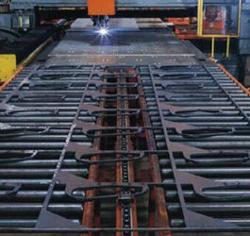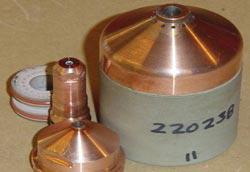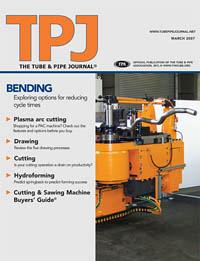Marketing Manager, Metal Fabrication
- FMA
- The Fabricator
- FABTECH
- Canadian Metalworking
Categories
- Additive Manufacturing
- Aluminum Welding
- Arc Welding
- Assembly and Joining
- Automation and Robotics
- Bending and Forming
- Consumables
- Cutting and Weld Prep
- Electric Vehicles
- En Español
- Finishing
- Hydroforming
- Laser Cutting
- Laser Welding
- Machining
- Manufacturing Software
- Materials Handling
- Metals/Materials
- Oxyfuel Cutting
- Plasma Cutting
- Power Tools
- Punching and Other Holemaking
- Roll Forming
- Safety
- Sawing
- Shearing
- Shop Management
- Testing and Measuring
- Tube and Pipe Fabrication
- Tube and Pipe Production
- Waterjet Cutting
Industry Directory
Webcasts
Podcasts
FAB 40
Advertise
Subscribe
Account Login
Search
The ABCs of PAC
Understand all aspects of the process to ensure better performance
- By W.F. Garth Stapon, Randy Damas, and Bob Einfeldt
- March 13, 2007
- Article
- Plasma Cutting
Precision plasma technology provides many operational benefits, in-cluding control of cut surface quality, minimal distortion, and precise control of the significant taper on the cut surface (see Figure 1). Several considerations should be taken into account when selecting a precision plasma cutting system for your application, but before you do that, it is useful to understand the basics of plasma cutting.
Plasma Arc Cutting Defined
Plasma arc cutting (PAC) can be defined as an electric arc cutting process that severs or cuts metal by melting a localized area with a constricted arc that removes the molten material with a high-velocity jet of extremely hot, ionized gas emerging from the constricting orifice in the torch.
The high-velocity plasma arc melts and removes the base material. PAC can be used to cut any electrically conductive metal if its thickness and shape permit full penetration by the plasma jet. Typically, materials up to 3 inches thick can be cut. PAC also can be used to cut nonferrous base materials such as aluminum and copper. Cutting speed is increased on ferrous metals that are less than 3 in. thick.
Types of Plasma Cutting
Conventional PAC. With this process, the arc is constricted only by the nozzle, and typically no shielding gas is added. The plasma gas usually is nitrogen or air, which is fed into the torch around the electrode. The electric arc is established between the nozzle and the substrate (transferred arc). Cutting capacity is reduced by up to 25 percent with the use of nitrogen when compared with air, but torch life is enhanced by the use of nitrogen, sometimes as much as 300 percent when compared with air. If air is to be used, steps should be taken to ensure that it is oil- and moisture-free.
Oxygen Plasma Arc Cutting. This process utilizes oxygen as the plasma (orifice) gas instead of nitrogen or air. The use of oxygen as the plasma gas produces an exothermic reaction that increases cutting speed. Oxygen plasma arc cutting is used primarily for mild steel.
Underwater Plasma Arc Cutting. This technology is ideally suited to numerically controlled shape cutting. Underwater cutting helps to eliminate the ultraviolet radiation and fumes associated with conventional PAC.
In underwater PAC, the substrate being cut is supported on a cutting table, with the top surface of the plate 2 to 3 in. beneath the surface of the water. A device that locates the submerged metal is critical to this fully automated process. Accurate height control is maintained by a sensor that monitors arc voltage. This method is not recommended for cutting aluminum because the hydrogen that is generated as a byproduct may be trapped under the plate, creating the potential for an explosion.
Precision Plasma Arc Cutting. Also called high-definition PAC, precision plasma arc cutting uses a nozzle design intended to increase arc constriction and energy density. Because of the higher arc energy, cut edge quality and squareness may be improved, particularly on material less than 3/8 in. thick.
Gas Flow
The orifice gas often has a lower flow rate than the shielding gas, but both can vary as changes in cutting current are made to accommodate different base metals. Most PAC equipment uses an orifice gas with no shielding gas.
Gas flow with most PAC systems is controlled by a gas pressure regulator and a flowmeter. Precision gas flow panels are essential for the successful operation of high-definition systems.
System Selection
To make the best PAC system selection for your specific processing needs, take into account the following factors:
- The gantry. A robust gantry with dual-side AC drives will increase reliability, improve arc length control, and have a tight work envelope. A strong beam will reduce torch rocking, and improved drive technology will enhance torch positioning.
- Gas delivery. An optimized gas delivery system will match the operational duty cycle and type of material to be cut. It is possible to save on plasma gas costs with membrane nitrogen as the gas supply.
- CNC. Optimized operating software will increase uptime and reduce scrap rates with features such as automatic plate alignment and uptime reporting. It also should allow job programming during operation.
- Flexibility. A system that is capable of multiprocess work, such as oxyfuel and plasma cutting, will maximize system flexibility.
- Pressure and gas flow requirements. Use cutting charts supplied by the torch manufacturers, and follow the recommendations for pressure and tip size for the base metal being cut. The correct plasma gas pressure and flow control help to optimize process performance, which is critical for high-definition (precision) plasma technology.
- Equipment enhancements. High-quality equipment, such as a high-precision torch positioning system, will maintain a consistent torch-to-work distance. Cut quality and consumable life also will be improved.
- Consumables. High-speed plasma consumables enhance cutting travel speeds and will lower production costs (see Figure 2).
Other important considerations are local service and repair, local inventory of plasma arc consumables, automatic feeding of the base material, downdraft technology for fume control, and remote programming for multiple locations.
W.F. Garth Stapon is marketing manager, metal fabrication, eastern region; Randy Damas is automated cutting specialist; and Bob Einfeldt is senior territory manager for Praxair Inc., 39 Old Ridgebury Road, Danbury, CT 06810, 800-772-9247, garth_stapon@praxair.com
www.praxair.com.
About the Authors
W.F. Garth Stapon
39 Old Ridgebury Road
Danbury, CT 06810
800-225-8247
Randy Damas
Automated Cutting Specialist
39 Old Ridgebury Road
Danbury, CT 06810
800-772-9985
Bob Einfeldt
Senior Territory Manager
39 Old Ridgebury Road
Danbury, CT 06810
800-772-9247
About the Publication
Related Companies
subscribe now

The Tube and Pipe Journal became the first magazine dedicated to serving the metal tube and pipe industry in 1990. Today, it remains the only North American publication devoted to this industry, and it has become the most trusted source of information for tube and pipe professionals.
start your free subscription- Stay connected from anywhere

Easily access valuable industry resources now with full access to the digital edition of The Fabricator.

Easily access valuable industry resources now with full access to the digital edition of The Welder.

Easily access valuable industry resources now with full access to the digital edition of The Tube and Pipe Journal.
- Podcasting
- Podcast:
- The Fabricator Podcast
- Published:
- 04/16/2024
- Running Time:
- 63:29
In this episode of The Fabricator Podcast, Caleb Chamberlain, co-founder and CEO of OSH Cut, discusses his company’s...
- Trending Articles
Zekelman Industries to invest $120 million in Arkansas expansion

3D laser tube cutting system available in 3, 4, or 5 kW

Corrosion-inhibiting coating can be peeled off after use

Brushless copper tubing cutter adjusts to ODs up to 2-1/8 in.

HGG Profiling Equipment names area sales manager

- Industry Events
16th Annual Safety Conference
- April 30 - May 1, 2024
- Elgin,
Pipe and Tube Conference
- May 21 - 22, 2024
- Omaha, NE
World-Class Roll Forming Workshop
- June 5 - 6, 2024
- Louisville, KY
Advanced Laser Application Workshop
- June 25 - 27, 2024
- Novi, MI





























